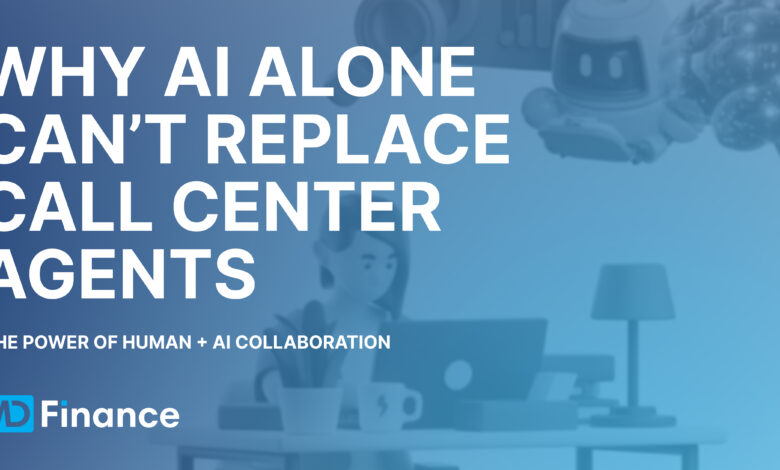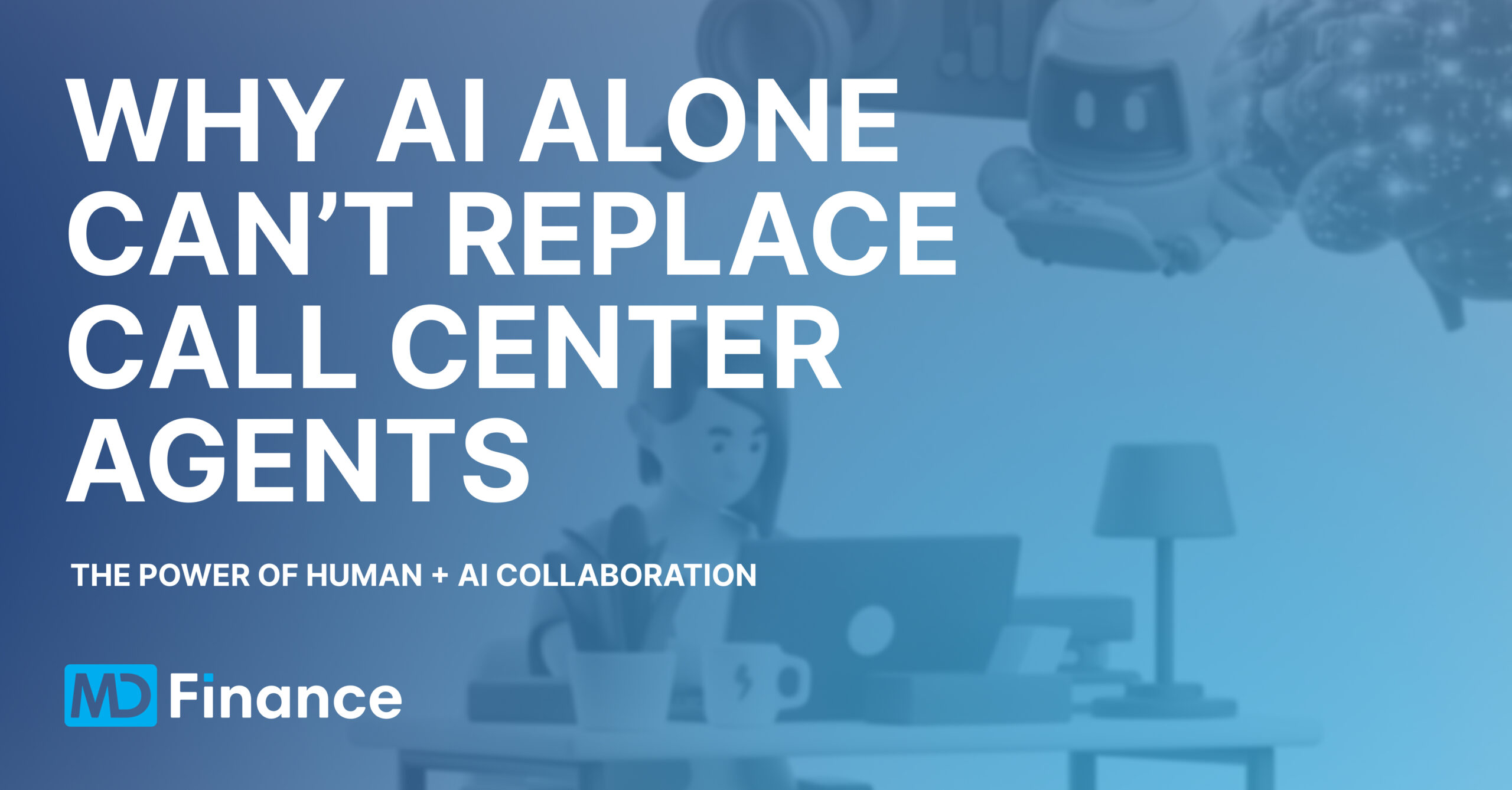
“AI‑Enabled” VS. “AI‑Replaced”
Working as an AI expert at MD Finance, I’ve seen firsthand why AI should amplify human capabilities rather than replace them. If AI could truly replace people, call centers wouldn’t still be grappling with 30-45% annual turnover and rising workloads, they’d be empty. Instead, organizations observe that fully automated conversations often lack empathy, nuance, and contextual judgment-precisely the ingredients that build trust, defuse conflict, and close commitments.
Here’s why AI still falls short solo, and why a partnered approach works better:
- Context outside Data: Models reason on patterns they’ve seen. Unusual regulatory nuances, cultural subtleties, or incomplete records still require human interpretation.
- Non‑Routine Scenarios and Ambiguity: Scripts can’t anticipate every branching path. When a customer’s situation diverges from “typical,” it’s the human who can reframe questions, reprioritize objectives, or pause for clarification.
- Trust & Accountability: Customers want to know a responsible human is ultimately accountable. AI can flag a red alert; a person has to make the call on how to act.
- Empathy & Moral Judgment: AI can measure sentiment but cannot authentically empathize or ethically weigh edge cases (e.g., a debtor dealing with a medical crisis). Humans are better at “reading the room” and choosing humane exceptions.
This is why skilled agents still outperform pure AI in many situations. Therefore, our goal was not to substitute people with algorithms, but to amplify human capability – using AI to surface insights, standardize evaluation, and accelerate learning.
Our Goal and Why It Matters
Our goal is to ensure that every call meets quality standards and every agent receives targeted coaching – through automatic transcription/translation and intent and criteria-based evaluation.
We aim to:
- Cover 100% of calls with consistent, criteria-based evaluation.
- Achieve ≥90% accuracy both in classifying conversation types and in scoring critical components of each call.
- Deliver actionable insights – not just “scores” – so supervisors coach faster, agents improve faster, and leadership steers the whole operation with confidence.
Why do we do it:
Fairness & Transparency: Random sampling misses patterns and invites bias. A full-coverage, explainable system creates a level playing field – every agent, every call, same rules.
Speed to Intervention: When a red flag (e.g., aggression, script violation) is triggered, we need to know today. This immediacy protects customers, brand reputation, and revenue.
Continuous Skill Development: High turnover means constant onboarding. Automated scoring pinpoints each agent’s “growth edges” (e.g., weak argumentation), making coaching surgical rather than generic.
Leadership Insight: Executives need a reliable single source of truth. Aggregated dashboards reveal trends by product, debt segment, or team.
A High-Level View of the Solution
Our platform consists of five main components:
- Listen & Decode: Every call is transcribed and, if needed, translated into a common analysis language.
- Score to Criteria: Predefined, weighted criteria (set by supervisors and business owners) yield a 0–1 call score and flag violations (e.g., profanity).
- Store & Show: Results populate a database and dashboards – management sees trends, supervisors see filters and red alerts, agents see personal scorecards.
- Human Feedback: Supervisors review questionable calls, adjust labels or scores, and add notes – creating a transparent feedback loop.
- Improve the Brain: Periodically, the model is retrained using supervisor feedback to maintain and lift accuracy.
Impact on Role Changes and Skill Evolution
By pairing humans with AI, we elevated call quality and saw the payoff in core KPIs – better client experience, higher conversion rates, and stronger debt‑collection ratios.
The platform’s implementation also reshaped roles across the call center.
Supervisors: coaching moves to the front seat
Instead of hunting for issues, they now respond quickly to flagged calls or recurring patterns in an agent’s performance. With objective, component-level gaps in hand, they design targeted coaching plans and spend more time developing people than on the policing process.
Agents: from “call doers” to continuous learners
Calls are no longer “mechanical tasks,” but practical tasks in an ongoing learning journey. Equipped with clear scorecards and trend lines, agents see exactly where they’re losing points and address those areas through tailored training. Engagement rises, and the path from novice to proficient communicator shortens.
A new role emerged: the LLM QA.
This specialist monitors model accuracy, fairness, and drift; validates bias checks and gathers data for fine‑tuning. By institutionalizing model stewardship, we made continuous improvement a core function.
Key Success Ingredient: A Culture of Adoption
Any system only works if people use it. Success hinged on staff adoption – not just technical excellence.
Dispel the “replacement” myth. We were explicit: AI is a copilot, not a replacement. We mapped out how it upskills agents (clear growth targets, faster feedback) and frees supervisors to do higher-value coaching.
Build trust in the model. Results had to be explainable, auditable, and unbiased. Transparent criteria, documented overrides, bias checks, and an LLM QA role made “why this score?” answerable – and fixable.
Normalize continuous growth. We framed the platform as part of an ongoing learning culture: short feedback loops, visible wins, and regular rituals (retros, micro-trainings) that celebrate improvement and tech fluency.
Summary: Lessons We Took Forward
Augmentation Outperforms Substitution: The most sustainable gains came from amplifying human strengths – not chasing full automation.
Clarity Breeds Trust: Explicit criteria, visible metrics, and rapid incorporation of feedback turned skepticism into engagement.
Roles Evolve with the System: Supervisors spend far more time coaching with data-backed insights, agents use transparent scorecards to drive their improvement, and an LLM QA function safeguards fairness, accuracy, and drift.
Iteration is Strategy: Continuous retraining, short feedback cycles, and open challenge channels kept both the AI and the people learning.
Culture Is the Multiplier: Technology provided the capability; a collaborative, accountable culture delivered the value.





